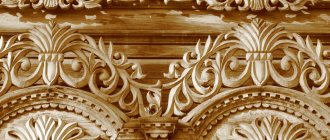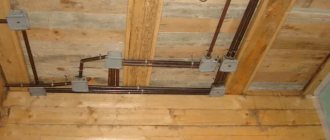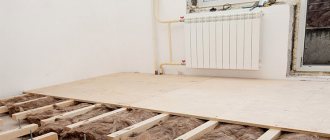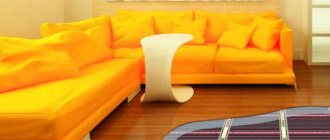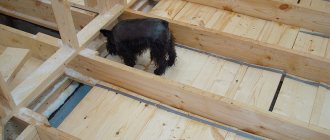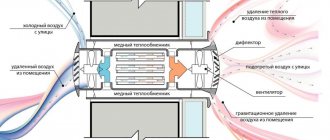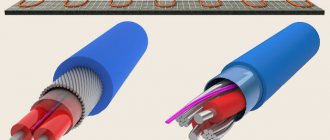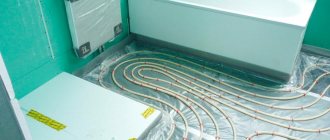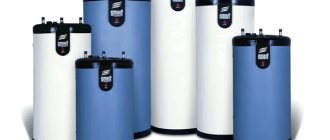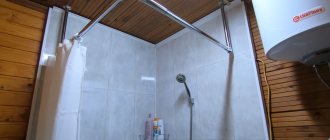- Infrared film heated floor
- Heating cable
- Heating mats
A building made of wood does not imply a thick monolithic cement floor screed into which a “traditional” water or cable (electric) heated floor is laid. As a rule, in this kind of house, the interfloor ceiling and foundation (most often logs) are wooden. In this case, the floor covering, for example, solid boards (tongue and groove), can be laid on the logs themselves or, in the case of laminate and parquet, on top of sheet materials such as plywood and OSB.
In this regard, many have difficulties in choosing and installing heated floors in a wooden house. Our article will help you figure this out.
underfloor heating systems . Let's look at each of them.
Infrared film heated floor
Thermal film is the simplest and most effective type of heated floor in a wooden house, designed specifically for heat-sensitive coatings (tongue and groove, linoleum, laminate, parquet and carpet) and its installation does not require screed or glue. The film is installed on any floor base: old covering, rough wooden floor and wood-containing sheet materials (plywood, chipboard, fiberboard, OSB).
Film heated floors are a source of additional heating, and with good thermal insulation and installation on 70-80% of the entire floor area, they are the main source of heat.
Warm floor for the main heating of a wooden house:
- CALEO Platinum 230 W/m2;
- CALEO Gold 230 W/m2;
- KEEPLY Optimal 200 W/m2;
- VIOLET FLOOR 210 W/m2.
As an additional source of heat and maintaining a comfortable indoor climate:
- CALEO Line;
- KEEPLY Basic 140 W/m2;
- CALEO Gold 170 W/m2;
- CALEO Platinum 230 W/m2;
- VIOLET FLOOR 130 W/m2.
Installation of such a warm floor is the same for all rooms. Detailed instructions are provided in the following article.
Types and their application features
The first designs of this type have been known since the times of Ancient Rome. They were used in baths. It was a bulky system of pipes through which air heated in the furnace circulated.
Modern models differ significantly from their ancient counterparts. Nowadays they have become progressive, and therefore in demand. They are used in residential and office premises, on balconies and even open terraces.
There are two types of such heating systems on the market:
- Electric
- Vodyany
The first model became the most widespread due to its ease of installation, ease of use and the ability to install under any floor covering.
The basis of such a system is a heating cable. The service life and performance of the system depend on its quality execution. Its operating principle is to supply voltage to the cable, which, due to its design features, is converted into thermal energy. At the same time, the cable itself heats up, transferring heat to the layer of concrete screed, and through it to the surface.
Electric models are available in three types:
- Film
- Standard (cable)
- Thin (mats)
Film or infrared can be installed for several hours, and it is successfully used not only for heating horizontal, but also vertical surfaces. For example, mounting it on the back of a dressing mirror will prevent fogging. It can be used as the main and additional source of heat in the house. Infrared heated floors can be installed under a wooden floor using any coating.
Types of electric models
A special feature of this design is that the cable is fixed to a plastic mesh. Installation of such a system comes down to placing the mat on a previously prepared surface. If it is necessary to give the structure the desired shape, the mesh can be cut.
Heating mats under tiles have a low linear power, which allows them to be placed in a layer of tile adhesive. In this case, turning on the system is allowed only a few days after the mixture has dried. And since the cable is located directly under the tile, it will warm up very quickly.
A standard heated floor consists of heating elements with high linear power. Therefore, its installation involves placing a layer of cement screed on top with a thickness of 3 cm. The installation of such a system requires certain skills and knowledge, so it is better if this work is performed by professionals.
Another disadvantage of such a system is that it can only be turned on after the solution has completely dried, after about a month.
Keeply BASIC 140 1 sq.m., 0.5
| Manufacturer: | KEEPLY |
| Model: | BASIC 140 |
| View: | heating film |
| Type of heating: | infrared |
| Power: | 140 W |
| Heating area: | 1 m2 |
| Installation type: | dry installation |
for comparison
RUB 2,036
Product added to cart
| Photo | Name | Price per piece | Quantity | Price |
| Keeply BASIC 140 1 sq.m., 0.5 | 2,036 rub. | < 1 > | 2,036 2,036 rub. |
There are 0 items in the cart worth 0 rub.
Go to cart
Buy
Availability
Choice of linoleum
This aspect must be treated with full attention precisely because linoleum, when heated, can release toxic substances into the environment. And then you can use the floors only at your own peril and risk to your health.
How to choose the right linoleum
Table. Types of linoleum.
| View | Description |
| Polyvinyl chloride | This is the cheapest, and therefore the most common option. It is based on ordinary PVC, which is heat sensitive. This material is distinguished by a wide variety of color variations, can have different thicknesses, and also have a base in the form of insulating material. Unfortunately, when laid on heated floors, this particular material not only begins to release toxic substances into the air, but also shrinks and begins to smell unpleasant. |
| Marmoleum | This is a natural type of coating that is of high quality and high price. It is not afraid of fire, does not become electrified, and when heated, almost does not release toxic substances into the air. It contains natural dyes, wood and cork flour, pine resin, and linseed oil. It is also usually based on jute fabric. This linoleum is easy to clean, does not fade in the sun and does not lose its appearance for many years. The only thing he doesn't like is washing with alkali-containing substances. Under the influence of alkali it will begin to collapse. |
| Relin | This linoleum contains bitumen, rubber, rubber. It does not tolerate heat and therefore, in general, is extremely rarely installed in houses and apartments; more often it can be seen in a number of industrial premises. When heated, it releases substances that are quite dangerous to humans. It is strictly prohibited to use it with a floor heating system. |
| Nitrocellulose | This material is also called colloxylin. It is not afraid of water, elastic, thin, but does not like heat. So it cannot be used with a heating system. |
| Alkyd | Also called glyphthalic. A synthetic material that is also fabric based. It’s worth saying right away that, like the previous options, it does not like heating. But it can be used in combination with heated floors, since it does not emit excessive amounts of hazardous substances. |
The process of laying linoleum
According to the information in the table, marmoleum or PVC material can be installed on wooden floors with heating systems. However, experts note that both options can be laid on water floors, but it’s better to put marmoleum on film floors.
Important! When choosing linoleum, you should take into account its thermal conductivity. If this indicator is very low, then there is no point in laying it on top of a warm floor - the material simply will not heat up and heating will be pointless. The thermal conductivity of a material depends on what it is made of.
Table with a list of linoleum characteristics
Keeply OPTIMAL 200 1 sq.m., 0.5
| Manufacturer: | KEEPLY |
| Model: | OPTIMAL 200 |
| View: | heating film |
| Type of heating: | infrared |
| Self-regulation effect: | Yes |
| Power: | 200 W |
| Heating area: | 1 m2 |
| Installation type: | dry installation |
for comparison
RUB 3,049
Product added to cart
| Photo | Name | Price per piece | Quantity | Price |
| Keeply OPTIMAL 200 1 sq.m., 0.5 | RUR 3,049 | < 1 > | 3,049 3,049 rub. |
There are 0 items in the cart worth 0 rub.
Go to cart
Buy
Availability
Preparing the wooden base
As practice shows, it is possible to lay any type of heated floor not only on a new, but also on an old wooden base. It is clear that it must be carefully prepared.
First of all, you need to get rid of all the cracks and gaps. Otherwise, the system will not be able to work effectively. A new base that is not coated with paint or impregnated with drying oil must be treated with an antiseptic solution and wait until it dries completely.
The next stage is leveling the base. The water heated floor system allows for small differences in height, since the pipes will be laid on supports with recesses. In this case, careful alignment is not required. Whereas infrared film heaters require a perfectly flat base.
If significant differences in height are detected, you will have to use scraping or lay a leveling coating, for example, sheets of plywood. In the latter case, you need to make sure that the edges of the canvases are laid in the same plane and fit very tightly to each other.
Caleo Platinum 230 1 sq.m., 0.5
| Manufacturer: | Caleo |
| Model: | PLATINUM 230 |
| View: | heating film |
| Type of heating: | infrared |
| Self-regulation effect: | Yes |
| Power: | 230 W |
| Heating area: | 1 m2 |
| Installation type: | dry installation |
for comparison
To order
Pipe laying options and techniques
There are several technologies for arranging TP in rooms with floor coverings based on ordinary boards. For the average user, the simplest options are suitable, involving installation on joists and laying along special guides (rack method).
Laying option on joists
In order not to damage the pipes, they are laid in special logs for heated floors.
The installation of floors begins with the preparation of a reliable wooden base. If rotten floorboards are found in the existing covering, they are replaced with fresh boards. Further actions are carried out in the following sequence:
- Along the edges of the repaired floor, two side beams with grooves for transverse supports-floors are attached to brackets.
- First, ready-made logs are laid in them, set strictly according to the level and secured in any convenient way.
- After fixing them, plates of the selected insulation are laid between the individual transverse boards. Most often these are slabs based on foam plastic or basalt wool.
- The heating elements themselves (electric cables, for example) are placed in pre-prepared grooves, secured using jumpers attached to the kit.
Upon completion of laying the heat-insulating mat, they begin to design a protective flooring, for which it is allowed to use sheets of moisture-resistant plywood with a thickness of at least 3 cm. A finished floor of linoleum or inlaid parquet is installed on top of the finished base.
Along guides made of slats
Aluminum guide rails have high thermal conductivity and reflect heat inward.
This method is more suitable for water-heated floors. To implement rack and pinion technology, additional parts will be required, for which special guides are used. In this case, the order of installation operations looks like this:
- A reliable base is prepared from laid floorboards, damaged or rotten samples of which are replaced with new ones.
- It is carefully leveled, support bars are mounted on top, and free niches are covered with mineral wool mats or foam plates.
- A layer of waterproofing is laid on top of them, covered with moisture-resistant plywood on top.
- Ready-made rack guides are taken and placed directly on its surface according to a pre-designed diagram for laying a “snake” of pipes. The elements of the TP will be recorded in them.
- The resulting gaps are sealed with reflective material.
Separate tubes of water-heated floors are placed in the prepared grooves, covered on top with heat-reflecting material. This type of installation of a heating system is quite labor-intensive, but it guarantees the reliability of its operation and does not require significant expenses from the contractor.
Expert advice
When installing a water circuit, it is pressurized for several days with high pressure.
Experts in laying warm water floors on a wooden floor advise adhering to the following recommendations:
- In rotating sections, the sharp corners of the guide rails are pre-rounded, which eliminates the possibility of damage to the coolant tubes.
- The aluminum foil used to retain heat is selected with a thickness of at least 50 microns.
- During installation, it is pressed forcefully into the grooves, bending around each recess in them.
- You can prevent the foil sheets from moving by fixing them on the slats using a construction stapler.
- For better heat transfer, water tubes are also wrapped in aluminum foil before installation.
Upon completion of the main work, the installed water floor is independently connected to the heating system. At the same time, it is subject to mandatory pressure testing, eliminating the possibility of leaks. If a visual inspection reveals no leaks, proceed to the next stage of work related to the installation of the finishing coating.
VIOLET FLOOR 130
| Manufacturer: | VIOLET FLOOR |
| View: | heating film |
| Type of heating: | infrared |
| Power per 1 m2: | 130 W |
| Equipment: | per cut |
| Length: | 1m |
| Width: | 0.5 m |
| Heating area: | 0.5 m2 |
| Installation type: | dry installation |
for comparison
430 rub. per linear meter
Product added to cart
| Photo | Name | Price per piece | Quantity | Price |
| VIOLET FLOOR 130 | 430 rub. per linear meter | < 1 > | RUB 430,430 |
There are 0 items in the cart worth 0 rub.
Go to cart
Buy
Availability
Go to the full catalog of infrared film for laminate CALEO
Connection to collector
Regardless of the chosen method of laying pipes for heated floors, they must be connected to the manifold. The first pipe is connected to the manifold that supplies hot water. The opposite end goes to the cooled water return collector. The pipes are secured using special nuts. Connecting the pipes to the collector is the final stage of installation; after this, the structure should not be subject to shifts, impacts, or other mechanical influences from the outside. At this stage, the entire system is checked. The boiler turns on at full power, the water entering the pipes will move under pressure. The pressure during testing exceeds the working pressure by 1.5 times. Under such conditions, the system must operate for at least 2 hours to ensure that there are no installation defects (pinched pipes, unreliable connections).
Heating cable
This heated floor is recommended if the floor is installed on joists. Just like infrared film, the heating cable is fireproof and can be used under solid wood, laminate, parquet boards, but with less efficiency.
The power of the heating cable for a wooden house should not exceed 80-100 W/m2 . For this purpose the following models are used:
- DEVIflex 18T (Denmark);
- THERMOcable SVK-20 (Sweden);
- IQ FLOOR CABLE and CLIMATIQ (Canada);
- Warmstad (Russia).
When installing such a warm floor, it is necessary to prepare the base. Thermal insulation (Figure, point No. 1) and heat-reflecting material (aluminum foil) are laid on the subfloor (base) between the joists. Then a thin metal mesh is installed on the heat-reflecting foil, to which the thermal cable is attached with clamps. The heating cable is installed in a snake parallel to the joists (laying step is 12-15 cm).
As shown in the figure, the thermal cable on the joists should be in the air gap, heating the space under the floor covering. Then, as with any other heated floor, the thermostat is installed and adjusted.
Laying laminate
Before laying the laminate after installing the electrical or water system, you must make sure that the assembled heated floor is functioning correctly. It is recommended to periodically start the system for 3 days, raising the temperature by 5 degrees every day.
If you created a water type of floor with your own hands, you must immediately apply maximum pressure and make sure that the pipeline is not damaged and that there are no various leaks. After checking, you need to wait until the coating has cooled to 15 degrees, then you can lay the laminate on a heated wooden floor.
When the installation is completed, the master begins laying the laminate:
- A polyethylene backing is created, it is placed end-to-end, and the seams are covered with construction tape.
- Laminate sheets are placed on the underfloor heating substrate. As a rule, sheets are not placed close to the wall; a gap of 5 mm is maintained. Otherwise, you must follow the manufacturer's recommendations.
We invite you to find out whether you need a substrate or not, which one to choose for laminate, what types there are and how to install it
IQ Floor Cable 10 m.
| Manufacturer: | IQ WATT |
| View: | heating cable |
| Power: | 200 W |
| Length of cable: | 10 m |
| Installation type: | in a screed 3-5 cm |
for comparison
RUB 4,590
Product added to cart
| Photo | Name | Price per piece | Quantity | Price |
| IQ Floor Cable 10 m. | 4,590 rub. | < 1 > | 4,590 4,590 rub. |
There are 0 items in the cart worth 0 rub.
Go to cart
Buy
Availability
Laying on a thin screed
Some wooden floors allow the possibility of screeding. At the same time, their design load limits the thickness of its layer to 5 cm, and more often to 3 cm. Heated water floors are laid on a wooden floor if there is a high-quality heat removal from the pipe. Following the standard principle of installing a water floor, the missing thickness is compensated with foil. The foil is laid in a dense layer directly under the screed. An additional material that helps to evenly distribute heat in the structure is reinforcing mesh, which simultaneously increases the strength of the screed. Filling the screed can only be done after laying the pipes and filling them with water. All further work can be done only a month after this.
Thermocable 8 m.
| Manufacturer: | Thermo |
| View: | heating cable |
| Power: | 165 W |
| Length of cable: | 8 m |
| Installation type: | in a screed 3-5 cm |
for comparison
old price 5,002 rub.
RUB 4,502
Product added to cart
| Photo | Name | Price per piece | Quantity | Price |
| Thermocable 8 m. | 4,502 rub. | < 1 > | 4,502 4,502 rub. |
There are 0 items in the cart worth 0 rub.
Go to cart
Buy
Availability
Variations on a theme
In our country, based on Finnish technology, which facilitates the design and allows one to abandon monolithic casting, its variations have appeared - the principle remains, but the materials have been increased:
Gypsum fiber sheets (GVL) - compared to plasterboard, they are denser, more resistant to bending and deformation, and contain cellulose fibers and other additives that increase their technical characteristics. For wet rooms, a moisture-resistant variety (GVLV) is used;
ТishinFORUMHOUSE user
In such a floor, instead of plasterboard, it is better to use gypsum fiber sheets (GVL). I myself am now considering a dry screed for implementation in my home, I will only replace the bottom layer with OSB. I will assemble the middle part from two layers of gypsum fiber board.
Chipboard, OSB, plywood - in terms of heat transfer, this design is worse, since wood and its derivatives act as an insulator. Ready-made sets of heated floors on a dry screed made of chipboard sheets, with grooves selected for hinges, are sold, but not everyone can handle their cost.
boatmasterFORUMHOUSE user
Logs, with a pitch of 60 cm, plus insulation - 35 cm, OSB base, then a 20 mm pipe, plus a 5 mm clip, it turns out 25 mm, three layers of GVLV between the pipes 12 x 3 = 26 mm.
- Cement particle board (CSP);
- EPPS - pipes are laid directly into the insulation, and the voids are covered with glue. To increase the heat transfer of the elements, foil or similar material is used;
The thickness of the sheets for the middle layer with the main is selected based on the diameter of the pipe, so that after filling with glue, a flat surface is obtained, and the final layer does not put pressure on the pipe. As an option, two sheets are glued together if the thickness of one is not enough.
Forum users are actively organizing their underfloor heating systems on wooden floors.
Serg177 FORUMHOUSE user, Moscow.
If something happens to the pipe (today, tomorrow or in 25 years), you won’t have to break the screed. I will buy 50 sheets of plywood, 18 mm thick, for 200 m², cut it into strips, 16 mm pipe in between, and cover 200 sheets of ten sheets with laminate on top.
One of the options for making a dry screed with your own hands is laying pipes in special aluminum plates with grooves. They fit the pipes tightly and increase heat transfer. The disadvantage of this configuration is the high cost of these metal gaskets; their use increases the cost of the entire system.
Vladimir TallinFORUMHOUSE user
There are not enough special aluminum sheets that are placed under the pipe and remove heat to the top. I have them, they “hug” the pipe, the size is about 30 cm per meter, there is a groove for the pipe with rare spikes to hold the pipe.
Sheets on a gypsum base are one of the most popular, as an optimal material in all respects.
- Reasonably priced;
- Easily cut into segments;
- Eco-friendly (does not contain synthetic binders like wood-filled boards) and suitable for home use;
- Non-flammable;
Advantages of underfloor heating on a wooden floor
Wood does not conduct heat well, so it is an additional insulation.
Installation of TP on the surface of already laid boards with preliminary insulation of the base has a number of advantages, which are manifested:
- The work is carried out using absolutely “dry” technologies, the implementation of which eliminates the tedious procedures of mixing and pouring concrete mixtures.
- To prepare the base, it is enough to level the existing coating and lay bars on it under the logs.
- Insulation procedures are simplified, since there are already ready-made niches for laying mats or heat insulation plates.
- The floor itself is much easier to install, since there is no need for special clamps for thermal elements. They are installed and secured directly to the joists.
The work of decorating the finishing surface (linoleum, for example) is simplified because it can be mounted on a plywood flooring fixed to the same slats or joists.
